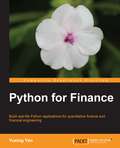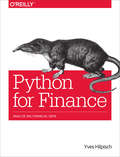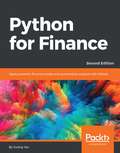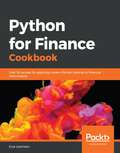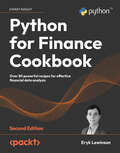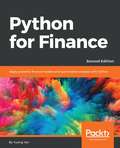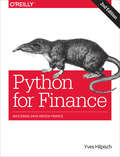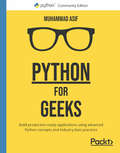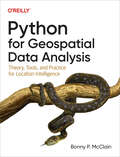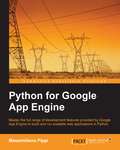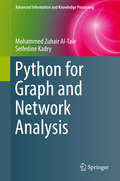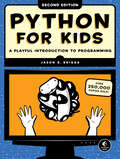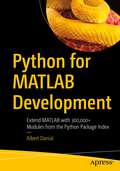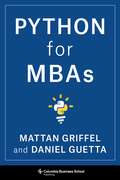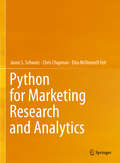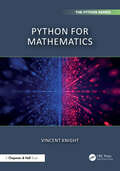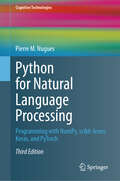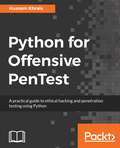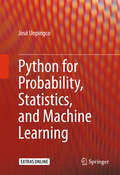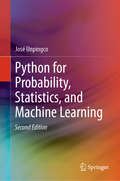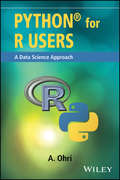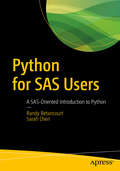- Table View
- List View
Python for Finance
by Yuxing YanA hands-on guide with easy-to-follow examples to help you learn about option theory, quantitative finance, financial modeling, and time series using Python. Python for Finance is perfect for graduate students, practitioners, and application developers who wish to learn how to utilize Python to handle their financial needs. Basic knowledge of Python will be helpful but knowledge of programming is necessary.
Python for Finance
by Yves HilpischThe financial industry has adopted Python at a tremendous rate recently, with some of the largest investment banks and hedge funds using it to build core trading and risk management systems. This hands-on guide helps both developers and quantitative analysts get started with Python, and guides you through the most important aspects of using Python for quantitative finance.Using practical examples through the book, author Yves Hilpisch also shows you how to develop a full-fledged framework for Monte Carlo simulation-based derivatives and risk analytics, based on a large, realistic case study. Much of the book uses interactive IPython Notebooks, with topics that include:Fundamentals: Python data structures, NumPy array handling, time series analysis with pandas, visualization with matplotlib, high performance I/O operations with PyTables, date/time information handling, and selected best practicesFinancial topics: mathematical techniques with NumPy, SciPy and SymPy such as regression and optimization; stochastics for Monte Carlo simulation, Value-at-Risk, and Credit-Value-at-Risk calculations; statistics for normality tests, mean-variance portfolio optimization, principal component analysis (PCA), and Bayesian regressionSpecial topics: performance Python for financial algorithms, such as vectorization and parallelization, integrating Python with Excel, and building financial applications based on Web technologies
Python for Finance - Second Edition
by Yuxing YanLearn and implement various Quantitative Finance concepts using the popular Python libraries About This Book • Understand the fundamentals of Python data structures and work with time-series data • Implement key concepts in quantitative finance using popular Python libraries such as NumPy, SciPy, and matplotlib • A step-by-step tutorial packed with many Python programs that will help you learn how to apply Python to finance Who This Book Is For This book assumes that the readers have some basic knowledge related to Python. However, he/she has no knowledge of quantitative finance. In addition, he/she has no knowledge about financial data. What You Will Learn • Become acquainted with Python in the first two chapters • Run CAPM, Fama-French 3-factor, and Fama-French-Carhart 4-factor models • Learn how to price a call, put, and several exotic options • Understand Monte Carlo simulation, how to write a Python program to replicate the Black-Scholes-Merton options model, and how to price a few exotic options • Understand the concept of volatility and how to test the hypothesis that volatility changes over the years • Understand the ARCH and GARCH processes and how to write related Python programs In Detail This book uses Python as its computational tool. Since Python is free, any school or organization can download and use it. This book is organized according to various finance subjects. In other words, the first edition focuses more on Python, while the second edition is truly trying to apply Python to finance. The book starts by explaining topics exclusively related to Python. Then we deal with critical parts of Python, explaining concepts such as time value of money stock and bond evaluations, capital asset pricing model, multi-factor models, time series analysis, portfolio theory, options and futures. This book will help us to learn or review the basics of quantitative finance and apply Python to solve various problems, such as estimating IBM's market risk, running a Fama-French 3-factor, 5-factor, or Fama-French-Carhart 4 factor model, estimating the VaR of a 5-stock portfolio, estimating the optimal portfolio, and constructing the efficient frontier for a 20-stock portfolio with real-world stock, and with Monte Carlo Simulation. Later, we will also learn how to replicate the famous Black-Scholes-Merton option model and how to price exotic options such as the average price call option. Style and approach This book takes a step-by-step approach in explaining the libraries and modules in Python, and how they can be used to implement various aspects of quantitative finance. Each concept is explained in depth and supplemented with code examples for better understanding.
Python for Finance Cookbook: Over 50 recipes for applying modern Python libraries to financial data analysis
by Eryk LewinsonSolve common and not-so-common financial problems using Python libraries such as NumPy, SciPy, and pandas Key Features Use powerful Python libraries such as pandas, NumPy, and SciPy to analyze your financial data Explore unique recipes for financial data analysis and processing with Python Estimate popular financial models such as CAPM and GARCH using a problem-solution approach Book Description Python is one of the most popular programming languages used in the financial industry, with a huge set of accompanying libraries. In this book, you'll cover different ways of downloading financial data and preparing it for modeling. You'll calculate popular indicators used in technical analysis, such as Bollinger Bands, MACD, RSI, and backtest automatic trading strategies. Next, you'll cover time series analysis and models, such as exponential smoothing, ARIMA, and GARCH (including multivariate specifications), before exploring the popular CAPM and the Fama-French three-factor model. You'll then discover how to optimize asset allocation and use Monte Carlo simulations for tasks such as calculating the price of American options and estimating the Value at Risk (VaR). In later chapters, you'll work through an entire data science project in the financial domain. You'll also learn how to solve the credit card fraud and default problems using advanced classifiers such as random forest, XGBoost, LightGBM, and stacked models. You'll then be able to tune the hyperparameters of the models and handle class imbalance. Finally, you'll focus on learning how to use deep learning (PyTorch) for approaching financial tasks. By the end of this book, you'll have learned how to effectively analyze financial data using a recipe-based approach. What you will learn Download and preprocess financial data from different sources Backtest the performance of automatic trading strategies in a real-world setting Estimate financial econometrics models in Python and interpret their results Use Monte Carlo simulations for a variety of tasks such as derivatives valuation and risk assessment Improve the performance of financial models with the latest Python libraries Apply machine learning and deep learning techniques to solve different financial problems Understand the different approaches used to model financial time series data Who this book is for This book is for financial analysts, data analysts, and Python developers who want to learn how to implement a broad range of tasks in the finance domain. Data scientists looking to devise intelligent financial strategies to perform efficient financial analysis will also find this book useful. Working knowledge of the Python programming language is mandatory to grasp the concepts covered in the book effectively.
Python for Finance Cookbook: Over 80 powerful recipes for effective financial data analysis, 2nd Edition
by Eryk LewinsonUse modern Python libraries such as pandas, NumPy, and scikit-learn and popular machine learning and deep learning methods to solve financial modeling problemsPurchase of the print or Kindle book includes a free eBook in the PDF formatKey FeaturesExplore unique recipes for financial data processing and analysis with PythonApply classical and machine learning approaches to financial time series analysisCalculate various technical analysis indicators and backtesting backtest trading strategiesBook DescriptionPython is one of the most popular programming languages in the financial industry, with a huge collection of accompanying libraries. In this new edition of the Python for Finance Cookbook, you will explore classical quantitative finance approaches to data modeling, such as GARCH, CAPM, factor models, as well as modern machine learning and deep learning solutions.You will use popular Python libraries that, in a few lines of code, provide the means to quickly process, analyze, and draw conclusions from financial data. In this new edition, more emphasis was put on exploratory data analysis to help you visualize and better understand financial data. While doing so, you will also learn how to use Streamlit to create elegant, interactive web applications to present the results of technical analyses.Using the recipes in this book, you will become proficient in financial data analysis, be it for personal or professional projects. You will also understand which potential issues to expect with such analyses and, more importantly, how to overcome them.What you will learnPreprocess, analyze, and visualize financial dataExplore time series modeling with statistical (exponential smoothing, ARIMA) and machine learning modelsUncover advanced time series forecasting algorithms such as Meta's ProphetUse Monte Carlo simulations for derivatives valuation and risk assessmentExplore volatility modeling using univariate and multivariate GARCH modelsInvestigate various approaches to asset allocationLearn how to approach ML-projects using an example of default predictionExplore modern deep learning models such as Google's TabNet, Amazon's DeepAR and NeuralProphetWho this book is forThis book is intended for financial analysts, data analysts and scientists, and Python developers with a familiarity with financial concepts. You'll learn how to correctly use advanced approaches for analysis, avoid potential pitfalls and common mistakes, and reach correct conclusions for a broad range of finance problems.Working knowledge of the Python programming language (particularly libraries such as pandas and NumPy) is necessary.
Python for Finance Second Edition
by Yuxing YanA hands-on guide with easy-to-follow examples to help you learn about option theory, quantitative finance, financial modeling, and time series using Python. Python for Finance is perfect for graduate students, practitioners, and application developers who wish to learn how to utilize Python to handle their financial needs. Basic knowledge of Python will be helpful but knowledge of programming is necessary.
Python for Finance: Mastering Data-Driven Finance
by Yves J. HilpischThe financial industry has recently adopted Python at a tremendous rate, with some of the largest investment banks and hedge funds using it to build core trading and risk management systems. Updated for Python 3, the second edition of this hands-on book helps you get started with the language, guiding developers and quantitative analysts through Python libraries and tools for building financial applications and interactive financial analytics.Using practical examples throughout the book, author Yves Hilpisch also shows you how to develop a full-fledged framework for Monte Carlo simulation-based derivatives and risk analytics, based on a large, realistic case study. Much of the book uses interactive IPython Notebooks.
Python for Geeks: Build production-ready applications using advanced Python concepts and industry best practices
by Muhammad AsifTake your Python skills to the next level to develop scalable, real-world applications for local as well as cloud deploymentKey FeaturesAll code examples have been tested with Python 3.7 and Python 3.8 and are expected to work with any future 3.x releaseLearn how to build modular and object-oriented applications in PythonDiscover how to use advanced Python techniques for the cloud and clustersBook DescriptionPython is a multipurpose language that can be used for multiple use cases. Python for Geeks will teach you how to advance in your career with the help of expert tips and tricks.You'll start by exploring the different ways of using Python optimally, both from the design and implementation point of view. Next, you'll understand the life cycle of a large-scale Python project. As you advance, you'll focus on different ways of creating an elegant design by modularizing a Python project and learn best practices and design patterns for using Python. You'll also discover how to scale out Python beyond a single thread and how to implement multiprocessing and multithreading in Python. In addition to this, you'll understand how you can not only use Python to deploy on a single machine but also use clusters in private as well as in public cloud computing environments. You'll then explore data processing techniques, focus on reusable, scalable data pipelines, and learn how to use these advanced techniques for network automation, serverless functions, and machine learning. Finally, you'll focus on strategizing web development design using the techniques and best practices covered in the book.By the end of this Python book, you'll be able to do some serious Python programming for large-scale complex projects.What you will learnUnderstand how to design and manage complex Python projectsStrategize test-driven development (TDD) in PythonExplore multithreading and multiprogramming in PythonUse Python for data processing with Apache Spark and Google Cloud Platform (GCP)Deploy serverless programs on public clouds such as GCPUse Python to build web applications and application programming interfacesApply Python for network automation and serverless functionsGet to grips with Python for data analysis and machine learningWho this book is forThis book is for intermediate-level Python developers in any field who are looking to build their skills to develop and manage large-scale complex projects. Developers who want to create reusable modules and Python libraries and cloud developers building applications for cloud deployment will also find this book useful. Prior experience with Python will help you get the most out of this book.
Python for Geospatial Data Analysis: Theory, Tools, and Practice for Location Intelligence
by Bonny P. McClainIn spatial data science, things in closer proximity to one another likely have more in common than things that are farther apart. With this practical book, geospatial professionals, data scientists, business analysts, geographers, geologists, and others familiar with data analysis and visualization will learn the fundamentals of spatial data analysis to gain a deeper understanding of their data questions.Author Bonny P. McClain demonstrates why detecting and quantifying patterns in geospatial data is vital. Both proprietary and open source platforms allow you to process and visualize spatial information. This book is for people familiar with data analysis or visualization who are eager to explore geospatial integration with Python.This book helps you:Understand the importance of applying spatial relationships in data scienceSelect and apply data layering of both raster and vector graphicsApply location data to leverage spatial analyticsDesign informative and accurate mapsAutomate geographic data with Python scriptsExplore Python packages for additional functionalityWork with atypical data types such as polygons, shape files, and projectionsUnderstand the graphical syntax of spatial data science to stimulate curiosity
Python for Google App Engine
by Massimiliano PippiIf you are a Python developer, whether you have experience in web applications development or not, and want to rapidly deploy a scalable backend service or a modern web application on Google App Engine, then this book is for you.
Python for Graph and Network Analysis
by Seifedine Kadry Mohammed Zuhair Al-TaieThis research monograph provides the means to learn the theory and practice of graph and network analysis using the Python programming language. The social network analysis techniques, included, will help readers to efficiently analyze social data from Twitter, Facebook, LiveJournal, GitHub and many others at three levels of depth: ego, group, and community. They will be able to analyse militant and revolutionary networks and candidate networks during elections. For instance, they will learn how the Ebola virus spread through communities. Practically, the book is suitable for courses on social network analysis in all disciplines that use social methodology. In the study of social networks, social network analysis makes an interesting interdisciplinary research area, where computer scientists and sociologists bring their competence to a level that will enable them to meet the challenges of this fast-developing field. Computer scientists have the knowledge to parse and process data while sociologists have the experience that is required for efficient data editing and interpretation. Social network analysis has successfully been applied in different fields such as health, cyber security, business, animal social networks, information retrieval, and communications.
Python for Kids, 2nd Edition: A Playful Introduction to Programming
by Jason R. BriggsThe second edition of the best-selling Python for Kids—which brings you (and your parents) into the world of programming—has been completely updated to use the latest version of Python, along with tons of new projects!Python is a powerful, expressive programming language that&’s easy to learn and fun to use! But books about learning to program in Python can be dull and gray—and that&’s no fun for anyone.Python for Kids brings Python to life and brings kids (and their parents) into the wonderful world of programming. Author Jason R. Briggs guides readers through the basics, experimenting with unique (and often hilarious) example programs that feature ravenous monsters, secret agents, thieving ravens, and more. New terms are defined; code is colored, dissected, and explained; and quirky, full-color illustrations keep things fun and engaging throughout.Chapters end with programming puzzles designed to stretch the brain and strengthen understanding. By the end of the book, young readers will have programmed two complete games: a clone of the famous Pong, and &“Mr. Stick Man Races for the Exit&”—a platform game with jumps, animation, and much more.This second edition has been completely updated and revised to reflect the latest Python version and programming practices, with new puzzles to inspire readers to take their code farther than ever before. Why should serious adults have all the fun? Python for Kids is the ticket into the amazing world of computer programming.
Python for Kids: A Playful Introduction To Programming
by Jason BriggsPython is a powerful, expressive programming language that’s easy to learn and fun to use! But books about learning to program in Python can be kind of dull, gray, and boring, and that’s no fun for anyone.Python for Kids brings Python to life and brings you (and your parents) into the world of programming. The ever-patient Jason R. Briggs will guide you through the basics as you experiment with unique (and often hilarious) example programs that feature ravenous monsters, secret agents, thieving ravens, and more. New terms are defined; code is colored, dissected, and explained; and quirky, full-color illustrations keep things on the lighter side.Chapters end with programming puzzles designed to stretch your brain and strengthen your understanding. By the end of the book you’ll have programmed two complete games: a clone of the famous Pong and "Mr. Stick Man Races for the Exit"—a platform game with jumps, animation, and much more.As you strike out on your programming adventure, you’ll learn how to:–Use fundamental data structures like lists, tuples, and maps–Organize and reuse your code with functions and modules–Use control structures like loops and conditional statements–Draw shapes and patterns with Python’s turtle module–Create games, animations, and other graphical wonders with tkinterWhy should serious adults have all the fun? Python for Kids is your ticket into the amazing world of computer programming.For kids ages 10+ (and their parents)The code in this book runs on almost anything: Windows, Mac, Linux, even an OLPC laptop or Raspberry Pi!
Python for MATLAB Development: Extend MATLAB with 300,000+ Modules from the Python Package Index
by Albert DanialMATLAB can run Python code!Python for MATLAB Development shows you how to enhance MATLAB with Python solutions to a vast array of computational problems in science, engineering, optimization, statistics, finance, and simulation. It is three books in one:A thorough Python tutorial that leverages your existing MATLAB knowledge with a comprehensive collection of MATLAB/Python equivalent expressionsA reference guide to setting up and managing a Python environment that integrates cleanly with MATLABA collection of recipes that demonstrate Python solutions invoked directly from MATLAB This book shows how to call Python functions to enhance MATLAB's capabilities. Specifically, you'll see how Python helps MATLAB:Run faster with numbaDistribute work to a compute cluster with daskFind symbolic solutions to integrals, derivatives, and series summations with SymPyOverlay data on maps with CartopySolve mixed-integer linear programming problems with PuLPInteract with Redis via pyredis, PostgreSQL via psycopg2, and MongoDB via pymongoRead and write file formats that are not natively understood by MATLAB, such as SQLite, YAML, and iniWho This Book Is ForMATLAB developers who are new to Python and other developers with some prior experience with MATLAB, R, IDL, or Mathematica.
Python for MBAs
by Mattan Griffel Daniel GuettaFrom the ads that track us to the maps that guide us, the twenty-first century runs on code. The business world is no different. Programming has become one of the fastest-growing topics at business schools around the world. An increasing number of MBAs are choosing to pursue careers in tech. For them and other professionals, having some basic coding knowledge is a must.This book is an introduction to programming with Python for MBA students and others in business positions who need a crash course. One of the most popular programming languages, Python is used for tasks such as building and running websites, data analysis, machine learning, and natural-language processing. Drawing on years of experience providing instruction in this material at Columbia Business School as well as extensive backgrounds in technology, entrepreneurship, and consulting, Mattan Griffel and Daniel Guetta teach the basics of programming from scratch. Beginning with fundamentals such as variables, strings, lists, and functions, they build up to data analytics and practical ways to derive value from large and complex datasets. They focus on business use cases throughout, using the real-world example of a major restaurant chain to offer a concrete look at what Python can do. Written for business students with no previous coding experience and those in business roles that include coding or working with coding teams, Python for MBAs is an indispensable introduction to a versatile and powerful programming language.
Python for Marketing Research and Analytics
by Chris Chapman Elea McDonnell Feit Jason S. SchwarzThis book provides an introduction to quantitative marketing with Python. The book presents a hands-on approach to using Python for real marketing questions, organized by key topic areas. Following the Python scientific computing movement toward reproducible research, the book presents all analyses in Colab notebooks, which integrate code, figures, tables, and annotation in a single file. The code notebooks for each chapter may be copied, adapted, and reused in one's own analyses. The book also introduces the usage of machine learning predictive models using the Python sklearn package in the context of marketing research. This book is designed for three groups of readers: experienced marketing researchers who wish to learn to program in Python, coming from tools and languages such as R, SAS, or SPSS; analysts or students who already program in Python and wish to learn about marketing applications; and undergraduate or graduate marketing students with little or no programming background. It presumes only an introductory level of familiarity with formal statistics and contains a minimum of mathematics.
Python for Mathematics (Chapman & Hall/CRC The Python Series)
by Vincent KnightPython for Mathematics introduces readers to effective methods for doing mathematics using the Python programming language. Most programming texts introduce readers to the building blocks of programming and build up to using more sophisticated tools for a specific purpose, like doing particular mathematical tasks. This is akin to teaching someone how to forge metal so as to make a nail, and then slowly working up to using sophisticated power tools so as to actually build something. This book does things in a different way, by first getting readers to begin using and understanding the tools that are going to be helpful to them as mathematicians, and only then moving onto the granular details. In this way, the practical application of the tools can aid in the understanding of the theory.Features· Complete with engaging, practical exercises· Many useful and detailed coding examples· Suitable for undergraduates in mathematics, and other quantitative sciences· Empowers readers to design and create their own Python tools.
Python for Natural Language Processing: Programming with NumPy, scikit-learn, Keras, and PyTorch (Cognitive Technologies)
by Pierre M. NuguesSince the last edition of this book (2014), progress has been astonishing in all areas of Natural Language Processing, with recent achievements in Text Generation that spurred a media interest going beyond the traditional academic circles. Text Processing has meanwhile become a mainstream industrial tool that is used, to various extents, by countless companies. As such, a revision of this book was deemed necessary to catch up with the recent breakthroughs, and the author discusses models and architectures that have been instrumental in the recent progress of Natural Language Processing.As in the first two editions, the intention is to expose the reader to the theories used in Natural Language Processing, and to programming examples that are essential for a deep understanding of the concepts. Although present in the previous two editions, Machine Learning is now even more pregnant, having replaced many of the earlier techniques to process text. Many new techniques build on the availability of text. Using Python notebooks, the reader will be able to load small corpora, format text, apply the models through executing pieces of code, gradually discover the theoretical parts by possibly modifying the code or the parameters, and traverse theories and concrete problems through a constant interaction between the user and the machine. The data sizes and hardware requirements are kept to a reasonable minimum so that a user can see instantly, or at least quickly, the results of most experiments on most machines.The book does not assume a deep knowledge of Python, and an introduction to this language aimed at Text Processing is given in Ch. 2, which will enable the reader to touch all the programming concepts, including NumPy arrays and PyTorch tensors as fundamental structures to represent and process numerical data in Python, or Keras for training Neural Networks to classify texts. Covering topics like Word Segmentation and Part-of-Speech and Sequence Annotation, the textbook also gives an in-depth overview of Transformers (for instance, BERT), Self-Attention and Sequence-to-Sequence Architectures.
Python for Offensive PenTest: A practical guide to ethical hacking and penetration testing using Python
by Hussam KhraisYour one-stop guide to using Python, creating your own hacking tools, and making the most out of resources available for this programming languageKey FeaturesComprehensive information on building a web application penetration testing framework using PythonMaster web application penetration testing using the multi-paradigm programming language PythonDetect vulnerabilities in a system or application by writing your own Python scriptsBook DescriptionPython is an easy-to-learn and cross-platform programming language that has unlimited third-party libraries. Plenty of open source hacking tools are written in Python, which can be easily integrated within your script.This book is packed with step-by-step instructions and working examples to make you a skilled penetration tester. It is divided into clear bite-sized chunks, so you can learn at your own pace and focus on the areas of most interest to you. This book will teach you how to code a reverse shell and build an anonymous shell. You will also learn how to hack passwords and perform a privilege escalation on Windows with practical examples. You will set up your own virtual hacking environment in VirtualBox, which will help you run multiple operating systems for your testing environment.By the end of this book, you will have learned how to code your own scripts and mastered ethical hacking from scratch.What you will learnCode your own reverse shell (TCP and HTTP)Create your own anonymous shell by interacting with Twitter, Google Forms, and SourceForgeReplicate Metasploit features and build an advanced shellHack passwords using multiple techniques (API hooking, keyloggers, and clipboard hijacking)Exfiltrate data from your targetAdd encryption (AES, RSA, and XOR) to your shell to learn how cryptography is being abused by malwareDiscover privilege escalation on Windows with practical examplesCountermeasures against most attacksWho this book is forThis book is for ethical hackers; penetration testers; students preparing for OSCP, OSCE, GPEN, GXPN, and CEH; information security professionals; cybersecurity consultants; system and network security administrators; and programmers who are keen on learning all about penetration testing.
Python for Probability, Statistics, and Machine Learning
by José UnpingcoThis book covers thekey ideas that link probability, statistics, and machine learning illustratedusing Python modules in these areas. The entire text, including all thefigures and numerical results, is reproducible using the Python codes and theirassociated Jupyter/IPython notebooks, which are provided as supplementarydownloads. The author develops key intuitions in machine learning by workingmeaningful examples using multiple analytical methods and Python codes, therebyconnecting theoretical concepts to concrete implementations. Modern Pythonmodules like Pandas, Sympy, and Scikit-learn are applied to simulate andvisualize important machine learning concepts like the bias/variance trade-off,cross-validation, and regularization. Many abstract mathematical ideas, such asconvergence in probability theory, are developed and illustrated with numericalexamples. This book is suitable for anyone with an undergraduate-levelexposure to probability, statistics, or machine learning and with rudimentaryknowledge of Python programming.
Python for Probability, Statistics, and Machine Learning
by José UnpingcoThis textbook, fully updated to feature Python version 3.7, covers the key ideas that link probability, statistics, and machine learning illustrated using Python modules. The entire text, including all the figures and numerical results, is reproducible using the Python codes and their associated Jupyter/IPython notebooks, which are provided as supplementary downloads. The author develops key intuitions in machine learning by working meaningful examples using multiple analytical methods and Python codes, thereby connecting theoretical concepts to concrete implementations. The update features full coverage of Web-based scientific visualization with Bokeh Jupyter Hub; Fisher Exact, Cohen’s D and Rank-Sum Tests; Local Regression, Spline, and Additive Methods; and Survival Analysis, Stochastic Gradient Trees, and Neural Networks and Deep Learning. Modern Python modules like Pandas, Sympy, and Scikit-learn are applied to simulate and visualize important machine learning concepts like the bias/variance trade-off, cross-validation, and regularization. Many abstract mathematical ideas, such as convergence in probability theory, are developed and illustrated with numerical examples. This book is suitable for classes in probability, statistics, or machine learning and requires only rudimentary knowledge of Python programming.
Python for Probability, Statistics, and Machine Learning
by José UnpingcoThis book, fully updated for Python version 3.6+, covers the key ideas that link probability, statistics, and machine learning illustrated using Python modules in these areas. All the figures and numerical results are reproducible using the Python codes provided. The author develops key intuitions in machine learning by working meaningful examples using multiple analytical methods and Python codes, thereby connecting theoretical concepts to concrete implementations. Detailed proofs for certain important results are also provided. Modern Python modules like Pandas, Sympy, Scikit-learn, Tensorflow, and Keras are applied to simulate and visualize important machine learning concepts like the bias/variance trade-off, cross-validation, and regularization. Many abstract mathematical ideas, such as convergence in probability theory, are developed and illustrated with numerical examples. This updated edition now includes the Fisher Exact Test and the Mann-Whitney-Wilcoxon Test. A new section on survival analysis has been included as well as substantial development of Generalized Linear Models. The new deep learning section for image processing includes an in-depth discussion of gradient descent methods that underpin all deep learning algorithms. As with the prior edition, there are new and updated *Programming Tips* that the illustrate effective Python modules and methods for scientific programming and machine learning. There are 445 run-able code blocks with corresponding outputs that have been tested for accuracy. Over 158 graphical visualizations (almost all generated using Python) illustrate the concepts that are developed both in code and in mathematics. We also discuss and use key Python modules such as Numpy, Scikit-learn, Sympy, Scipy, Lifelines, CvxPy, Theano, Matplotlib, Pandas, Tensorflow, Statsmodels, and Keras.This book is suitable for anyone with an undergraduate-level exposure to probability, statistics, or machine learning and with rudimentary knowledge of Python programming.
Python for R Users: A Data Science Approach
by Ajay OhriThe definitive guide for statisticians and data scientists who understand the advantages of becoming proficient in both R and Python The first book of its kind, Python for R Users: A Data Science Approach makes it easy for R programmers to code in Python and Python users to program in R. Short on theory and long on actionable analytics, it provides readers with a detailed comparative introduction and overview of both languages and features concise tutorials with command-by-command translations—complete with sample code—of R to Python and Python to R. Following an introduction to both languages, the author cuts to the chase with step-by-step coverage of the full range of pertinent programming features and functions, including data input, data inspection/data quality, data analysis, and data visualization. Statistical modeling, machine learning, and data mining—including supervised and unsupervised data mining methods—are treated in detail, as are time series forecasting, text mining, and natural language processing. • Features a quick-learning format with concise tutorials and actionable analytics • Provides command-by-command translations of R to Python and vice versa • Incorporates Python and R code throughout to make it easier for readers to compare and contrast features in both languages • Offers numerous comparative examples and applications in both programming languages • Designed for use for practitioners and students that know one language and want to learn the other • Supplies slides useful for teaching and learning either software on a companion website Python for R Users: A Data Science Approach is a valuable working resource for computer scientists and data scientists that know R and would like to learn Python or are familiar with Python and want to learn R. It also functions as textbook for students of computer science and statistics. A. Ohri is the founder of Decisionstats.com and currently works as a senior data scientist. He has advised multiple startups in analytics off-shoring, analytics services, and analytics education, as well as using social media to enhance buzz for analytics products. Mr. Ohri's research interests include spreading open source analytics, analyzing social media manipulation with mechanism design, simpler interfaces for cloud computing, investigating climate change and knowledge flows. His other books include R for Business Analytics and R for Cloud Computing.
Python for SAS Users: A SAS-Oriented Introduction to Python
by Randy Betancourt Sarah ChenBusiness users familiar with Base SAS programming can now learn Python by example. You will learn via examples that map SAS programming constructs and coding patterns into their Python equivalents. Your primary focus will be on pandas and data management issues related to analysis of data. It is estimated that there are three million or more SAS users worldwide today. As the data science landscape shifts from using SAS to open source software such as Python, many users will feel the need to update their skills. Most users are not formally trained in computer science and have likely acquired their skills programming SAS as part of their job. As a result, the current documentation and plethora of books and websites for learning Python are technical and not geared for most SAS users. Python for SAS Users provides the most comprehensive set of examples currently available. It contains over 200 Python scripts and approximately 75 SAS programs that are analogs to the Python scripts. The first chapters are more Python-centric, while the remaining chapters illustrate SAS and corresponding Python examples to solve common data analysis tasks such as reading multiple input sources, missing value detection, imputation, merging/combining data, and producing output. This book is an indispensable guide for integrating SAS and Python workflows. What You’ll Learn Quickly master Python for data analysis without using a trial-and-error approachUnderstand the similarities and differences between Base SAS and PythonBetter determine which language to use, depending on your needsObtain quick results Who This Book Is For SAS users, SAS programmers, data scientists, data scientist leaders, and Python users who need to work with SAS
Python for Scientists
by John M. StewartPython is a free, open source, easy-to-use software tool that offers a significant alternative to proprietary packages such as MATLAB and Mathematica. This book covers everything the working scientist needs to know to start using Python effectively. The author explains scientific Python from scratch, showing how easy it is to implement and test non-trivial mathematical algorithms and guiding the reader through the many freely available add-on modules. A range of examples, relevant to many different fields, illustrate the program's capabilities. In particular, readers are shown how to use pre-existing legacy code (usually in Fortran77) within the Python environment, thus avoiding the need to master the original code. Instead of exercises the book contains useful snippets of tested code which the reader can adapt to handle problems in their own field, allowing students and researchers with little computer expertise to get up and running as soon as possible.
